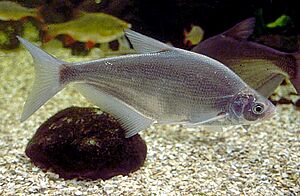Ballerus ballerus facts for kids
Quick facts for kids Ballerus ballerus |
|
|---|---|
 |
|
| Conservation status | |
| Scientific classification | |
| Synonyms | |
|
The zope, also known as the blue bream (scientific name: Ballerus ballerus), is a type of freshwater fish. It is a ray-finned fish, which means its fins are supported by bony spines called rays. This fish is part of the Leuciscidae family, which includes many common fish like carp and minnows. You can find the blue bream in rivers and lakes across Europe and parts of Western Asia.
Contents
What Does the Blue Bream Look Like?
The blue bream has a long, thin body that is flattened from side to side, especially near its tail. This shape helps it swim smoothly through the water. It has a mouth that points upwards and its eyes are quite small.
Its body is covered in small scales. Along its side, it has a special line of sensors called the lateral line, which helps it feel movement in the water. This line is made up of 67 to 75 scales. The fish is a shiny, pale silver color, and its fins are either clear or a light yellow.
A typical blue bream is about 25–35 cm (9.8–13.8 in) long, but some can grow to be 40 cm (16 in). The heaviest one ever officially recorded weighed 1.1 kg (2 lb 7 oz). However, an even bigger one was caught by an angler in Slovakia, weighing 2.2 kg (4 lb 14 oz) and measuring 53 cm (21 in) long!
During the spring breeding season, the male fish develop tiny bumps on their skin. These are called nuptial tubercles and are a normal part of their life cycle.
Where Can You Find the Blue Bream?
The blue bream lives in the large, slow-moving rivers of Europe and Western Asia. It is found in rivers that flow into several major seas:
- The Baltic Sea
- The North Sea
- The Black Sea
- The Caspian Sea
Its territory stretches from the Netherlands in Western Europe all the way to Russia and Georgia in the east. However, it doesn't live in the very cold rivers of northern Sweden and Finland.
Life Cycle and Behavior
The blue bream is a social fish that has interesting habits for finding food and raising its young.
Habitat and Diet
This fish prefers to live in large, slow-moving rivers and big lakes. It especially likes water that is eutrophic, which means the water is full of nutrients. These nutrients help grow lots of plankton, which are tiny plants and animals that float in the water. Plankton is the blue bream's main food source, and it swims near the surface to catch it.
Sometimes, the blue bream will even swim into the less salty parts of seas to look for food.
Reproduction and Growth
The blue bream's breeding season, called spawning, happens in the spring as soon as the winter ice melts. To lay their eggs, they swim into shallow parts of the river or lake that have lots of reeds and other plants. The sticky eggs attach to the plants, where they can develop safely.
Baby blue breams, called fry, stay hidden in these weedy areas after they hatch. This protects them from bigger fish. Once they grow up, the adult fish move back into the open water to feed.
A blue bream can live for more than 10 years. They are ready to have their own babies when they are 3 or 4 years old and have grown to about 150 mm (5.9 in) long. Spawning begins when the water warms up to 10 °C (50 °F) and only lasts for a week or two. During this time, male fish will often guard a small territory along the shore to attract a female.
To find the perfect spot to lay eggs, blue breams will sometimes migrate, traveling long distances up or down a river.
A Fun Fact: Zope Software
There is a computer application server called Zope. It is not named after the zope fish. The name is actually an acronym.
However, a later version of the software, called Zope 3, was given a new name: "Bluebream." This name was chosen as a tribute to one of the fish's common names!


